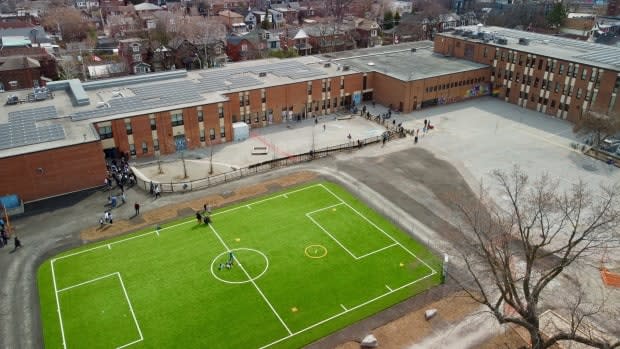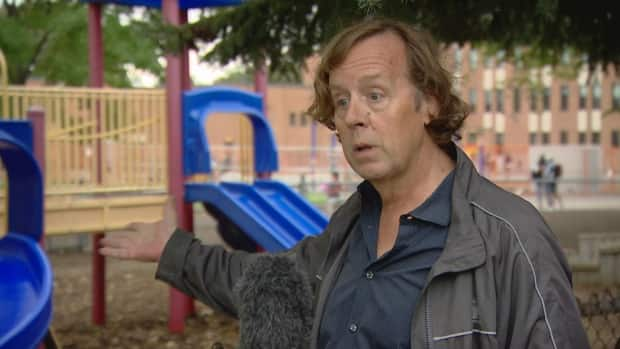Ontario schoolyards 'wasting an opportunity' for active play and need upgrading, study says

When their Toronto schoolyard was upgraded from a muddy field and shadeless asphalt to a playground and artificial turf, Annie Vandenburg said the way her two children play changed too.
Her kids and their classmates no longer seemed bored at recess but made up creative games, ran and played soccer and found quiet places to take a breath, said Vandenburg.
"Not only did it become more engaging and exciting for kids, but it can also become outdoor classrooms for teachers, like extensions of the inside," she said.
The rest of the upgrades to the schoolyard shared by Perth Avenue Junior Public School and St. Luigi Catholic School won't be completed until later this year, but Vandenburg, who worked for more than a decade with a non-profit organization to improve schoolyards across Canada, sees opportunities for tree planting and learning gardens.
But it's not the only one that requires a facelift.
Schoolyards across Ontario lack the necessities to encourage kids to get active, play imaginatively and connect with nature and need improvement, new research suggests.
Room for improvement
A study found 73 per cent of schools surveyed scored poorly when it comes to serving the needs of students. In particular, 10 per cent of schools had no fields, 13 per cent had no shade from trees and 16 per cent had no courts for sports like basketball, which Wilfrid Laurier University Prof. Kelly Gallagher-Mackay describes as appalling.
"That's just sticking up a hoop and painting some space on the ground," said Gallagher MacKay, who conducted the research with the Ontario Physical and Health Education Association.
The research also found close to half of high schools had no track and 13 per cent of elementary schools had no play equipment — "not a tether ball pole, nor simple monkey bars, nor multi-component structures," Gallagher-Mackay said.
"We've got 300 to 1,500 kids using this space for at least an hour a day and if we don't give them somewhere to play, we're wasting an opportunity to help kids get more active."

The researchers enlisted members of the general public to collect the data. They audited 232 schoolyards — five per cent of those in Ontario — giving scores for how well they were maintained and whether they provided opportunities for sports and play, active transportation and environmental engagement. Their findings include public, Catholic and French schools across different regions and income levels.
Schoolyards could score between -8 at the lowest to 88 at the highest. The vast majority, 73 per cent, had a score below halfway. The lowest score a schoolyard received was 14, the highest was 61.
The researchers found schoolyards received the lowest scores in environmental learning opportunities. In a third of schoolyards, more than half of the surface area is paved. About two-thirds of schoolyards didn't have a learning garden.
A renewed focus
Gallagher-Mackay suggested the province establish a minimum standard for school yards to fix the "immense variation" from one to the next, and school boards pursue partnerships with cities for bike racks and tree planting, and create spaces for kids to learn about the environment.
The Toronto District School Board pointed CBC News to its long-term plan, presented to school trustees earlier this year, to encourage outdoor learning. The plan acknowledges that with limited available funding, hundreds of schoolyards are in "poor condition" but in recent years more resources have been made available.
For example, since 2016 the annual playing field maintenance budget has doubled to $1 million and there's a grounds improvement fund to upgrade play equipment and outdoor spaces for kindergarten and special-needs students.
The Toronto Catholic District School Board said it's reviewing field conditions across its system to help set its future priorities. The board said it also planted more than 200 trees at 20 schools this fall and added bike racks at every school in partnership with the city.
Meanwhile, the Ministry of Education said it provides school boards $1.4 billion for building and yard repairs every year, and is spending "record amounts" to build new schools.

Kevin Putnam, a father of three who was also behind the push to improve the Perth Avenue-St. Luigi schoolyard, said over the 10 years he's noticed a change.
"I think [schoolyards] are starting to gain priority, not as fast as parents would like, but it has changed a bit," Putnam said.
Behind him the playground was busy.
"Kids are out here all the time just totally embracing it. It makes a huge difference."
He said when the schoolyard is complete it will be closer to the ideals outlined in Gallagher-Mackay's report.
"We won't be all the way there; there's still pavement and other things, but we're on the right path."


